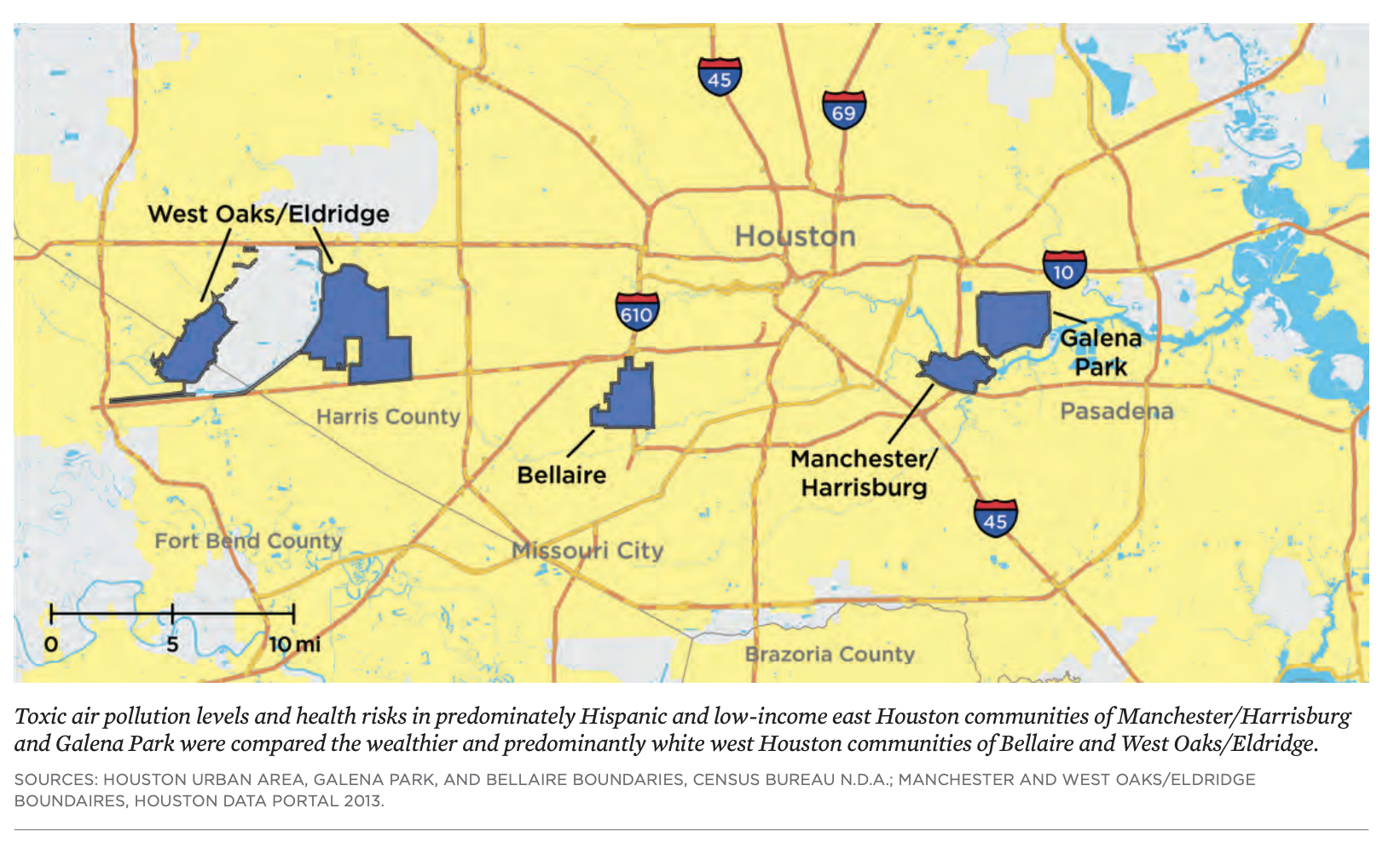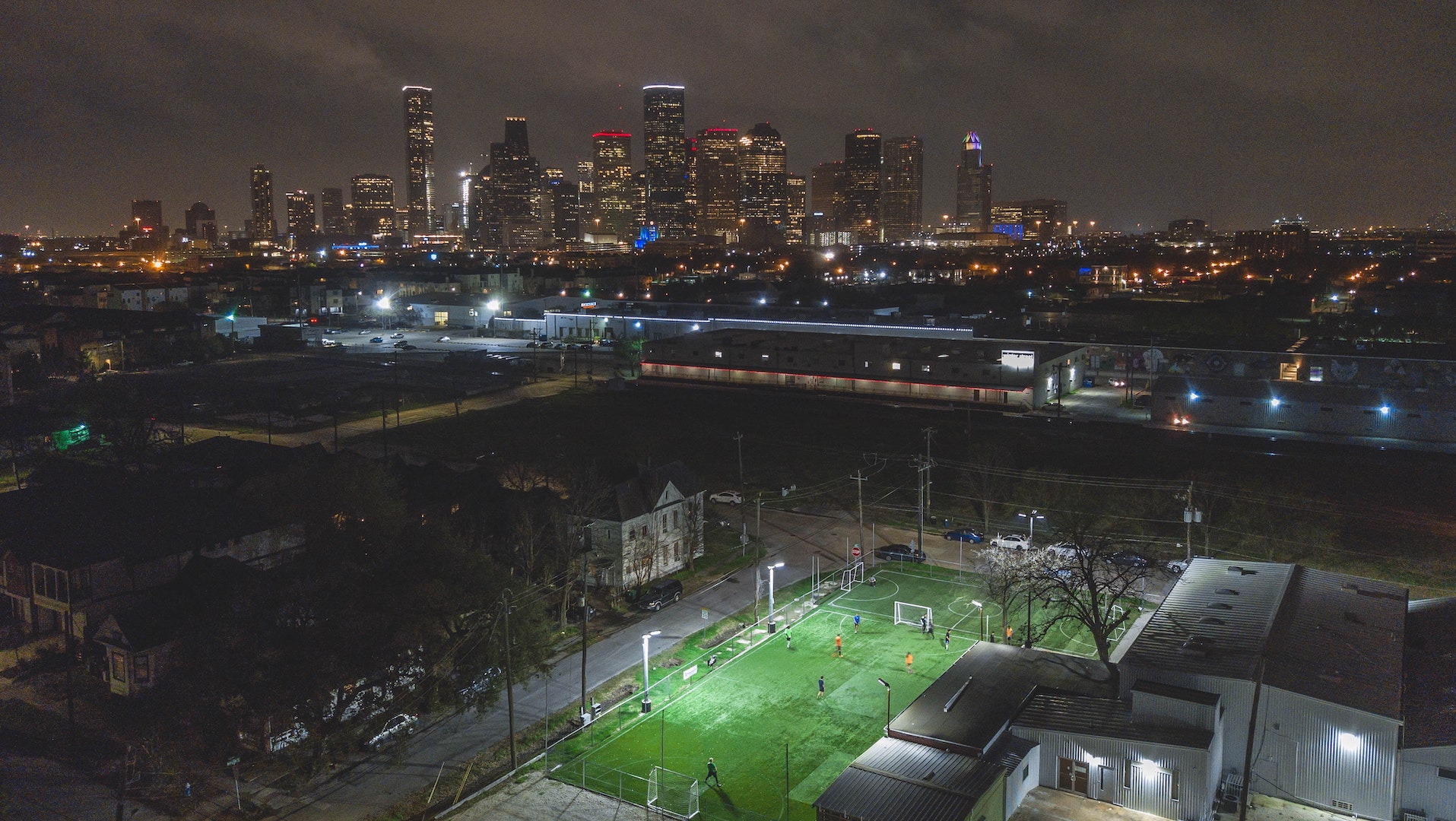There’s a saying that everything’s bigger in Texas. The state itself is massive, second in size to only Alaska. It’s also the second largest state by population, only bested by California. To the detriment of the people living in Texas, it’s also the largest producer of oil and natural gas in the country.
Half of the energy consumed in the state is by the industrial sector, most of which revolves around refineries and petrochemical plants. Due to its proximity to the Gulf of Mexico, Houston is the center of this industry, with most plants located along the Houston Ship Channel on the east side of the city.
Many of these plants have been known to emit far more pollutants than the law allows. For example, a penalty of $19.95 million was placed on Exxon in 2017 after a lawsuit was brought against them by Environment Texas, Sierra Club, and the National Environmental Law Center for violating the clean air act for over 16,000 days — more than 44 years of violations.
This pollution is far more diverse —and far deadlier — than carbon dioxide alone. Butadiene, benzene, ethylbenzene, toluene, and xylene are all toxic byproducts of the drilling and refining of oil. All of them can cause severe health problems with exposure. All, among many others, were found in the air over Manchester, a community in Houston.
Manchester and neighboring Harrisburg, situated on the east side of Houston, are made up of 98% People of Color (POC), with 37% living below the poverty line. Not coincidentally, there are seven facilities in Manchester that meet the EPA’s threshold of production to be required to report the release of hazardous materials.
In 2014, just four of these seven facilities released almost 500,000 pounds of pollutants into the air. Ninety percent of Manchester and Harrisburg residents live within one mile of one of these facilities.

This issue isn’t just confined to two neighborhoods, either. Galena Park, Bellaire, and West Oaks and Eldridge are three other communities in Houston experiencing air pollution. In Galena Park, 86% of residents are POC, and 21% of them live in poverty. Bellaire is made up of just 32% POC, and 3% live in poverty. West Oaks and Eldridge is 64% POC with a White plurality, of which 11% live in poverty.
A 2016 joint study by the Union of Concerned Scientists and Texas Environmental Justice Advocacy Services (T.E.J.A.S.) compared these neighborhoods, finding:
-
- Nearly half of Galena Park residents live within one mile of a plant. In comparison, less than 10% of Bellaire residents are within a mile of a plant, and less than 15% are for those who live in West Oaks and Eldridge.
- Plants by the east side neighborhoods have more accidents that warrant reporting per year than their west side counterparts.
The Impact of Climate Change
These accidents only serve to add to the hazards plaguing these communities, and the fact that they happen at a greater frequency near low income and predominantly People of Color neighborhoods is damning. But what makes this problem even worse is the fact that these accidents are increasing in frequency due to the primary crisis the oil and natural gas industry is perpetuating: climate change.
Hurricane Harvey caused massive damage to petrochemical facilities in Houston. According to the EDF, over one million pounds of toxins were released into the air due to damage caused by the hurricane. Two different reports found climate change to be a likely cause in increasing the amount of rainfall, and both found that climate change increased the odds of a Harvey-type storm threefold.
With climate change as an ongoing crisis, it’s only a matter of time before another Hurricane Harvey hits Houston, damaging these plants and releasing more toxic chemicals into the surrounding air. When that time comes, it’s critical that companies are better prepared for the storm, an issue that still has not been addressed.
How We Got Here
The United States has a long history of forcing POC to live in neighborhoods with overlapping health and environmental concerns, while being underserved by public services and investment. Texas is no exception. After reconstruction and during the Jim Crow era, many states implemented racist zoning laws, the impact of which is still felt by communities today.
In Lubbock, the use of zoning for segregation has been used since the 1920s, when the mayor at the time issued an ordinance that confined Black residents to the southeast side of the city. Subsequent land use plans placed industrial facilities around these communities, further separating them from the rest of the city.
These land use plans repeatedly singled out areas surrounding majority POC neighborhoods, even expanding industrial development near neighborhoods that had transitioned from majority White to majority POC since the previous plan. To this day, city officials refuse to address the problems that these communities still face.
Houston also has a history of manipulating the placement of its heavy industry to be near majority Black and POC neighborhoods. The city managed this by simultaneously trapping people in place, and encouraging industrial activity to move near them.
The method of structural racism the city used to keep the people in their neighborhoods is called redlining: the denial of services to people based on their location rather than their qualification, such as loans and mortgages.
The roots of the policy can be traced back to the Great Depression, when the housing market was destroyed, with half of all mortgages defaulted on and construction plummeting 95% in just five years. To combat this, the government formed the Home Owners’ Loan Corporation (HOLC).
HOLC served two main purposes. The first was innocuous: bail out homeowners who were at risk of defaulting their mortgages. The second was far more nefarious. According to Dr. Amy E. Hillier, professor at the University of Pennsylvania’s Leonard Davis Institute of Health Economics, around 1935 the HOLC “embarked on the ambitious and secretive City Survey Program to investigate real conditions in cities across the country. This program resulted in a series of residential security maps for 239 cities that were designed to ‘graphically reflect the trend of desirability of neighborhoods from a residential viewpoint.”

These maps categorized neighborhoods into four levels:
- Best, colored in green;
- Still Desirable, colored in blue;
- Definite Declining, colored in yellow; and
- Hazardous, colored in red (hence redlining).
The grades were assigned based on a number of factors, including race. What resulted was a vast majority of hazardous rated neighborhoods being neighborhoods of color.
While the exclusion of these neighborhoods existed prior to the surveys, the HOLC maps codified the oppression of the Black and POC living in their communities. People living in the redlined neighborhoods were essentially pushed aside by the government, and refused the loans and credit they needed to survive the Depression and prosper after it.
Simultaneously, a push was made by the government to make ‘better’ neighborhoods outside of the cities, spurring the creation of suburbs. In order to maintain the quality of these new neighborhoods, documents recommended tight restrictions on who could live there, including restricting race to just White people.
The byproduct of this segregation, systemic economic shutout, and white flight was property value declining rapidly in and near Black and POC neighborhoods. The cheap land proved attractive to industry, and the city made no attempts to stop them from moving in.
This all adds up to a situation in which residents of these low income, predominantly POC, neighborhoods are stuck in a position where their health is consistently being placed at a much greater risk than those around them.
How We Move Forward
While there is some action directed at the state and local level to leave oil and natural gas behind, this problem isn’t going to go away. Even if we manage to transition entirely away from oil and gas based electrical generation, the oil and petrochemical industry will still have a strong foothold in Houston.
Petrochemicals and petroleum products are the basis of thousands of products the world uses regularly, including the materials that are used to construct both solar panels and wind turbines. And where there’s demand for these products, there are oil pipelines and refineries used to supply it.
Put simply, even with a dramatic shift to green energy, the residents of marginalized neighborhoods still won’t be freed from the deadly air they’re forced to breathe. While there is research into reducing our reliance on petrochemicals through new and innovative chemical processes, we still have years ahead of us with petrochemicals as an integral part of our lives. It’s imperative that until the day arrives that we can replace them, these plants are operated more efficiently with green initiatives, responsibly relocated, and built to higher standards.
Despite the lack of active legislation that deals with these plants, and no clear path towards decommissioning, moving, or renovating them, there are groups that focus on holding the companies accountable for their pollution and helping the voices of Texas communities be heard.
How you can help
T.E.J.A.S., the group which co-authored the report on the four Houston neighborhoods, is principled on the basis that everyone, regardless of race or income, is entitled to live in a clean environment. They promote environmental protection through education, policy development, community awareness, and legal action. You can donate to help support them on their website, as well as sign up to volunteer.
Environment Texas, the state chapter of Environment America, advocates for all aspects of fixing the environment, including dealing with polluting industries. According to Luke Metzger, executive director of the group, they conduct a yearly study on illegal air pollution by facilities in Texas. On top of these reports, they often advocate for legislation against polluters. You can donate to them on their website, as well as apply for a position.
The Lone Star chapter of the Sierra Club organization also investigates and draws attention to violations of the clean air act by Texas industry, on top of advocating for clean energy alternatives. You can support them by donating or signing up to volunteer on their website.









